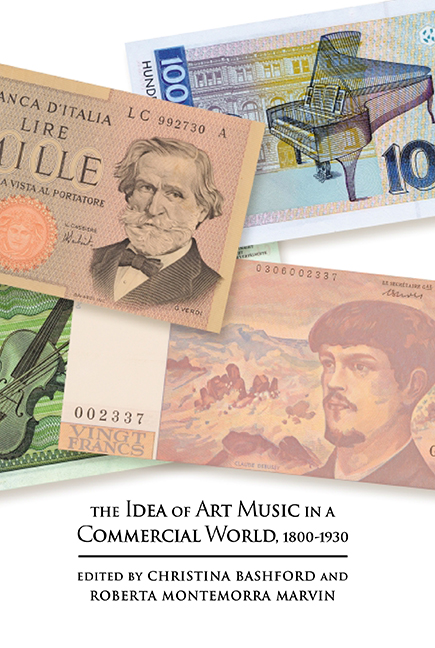Book contents
- Frontmatter
- Contents
- List of Figures
- List of Tables
- Notes on Contributors
- Acknowledgements
- A Note on Translations
- Bibliographic Abbreviations
- Introduction: The Idea of Art Music in a Commercial World
- PART I PUBLISHERS
- PART II PERSONALITIES
- PART III INSTRUMENTS
- PART IV REPERTOIRES
- PART V SETTINGS
- Index
- Music in Society and Culture
4 - Jenny Lind, Illustration, Song and the Relationship between Prima Donna and Public
Published online by Cambridge University Press: 27 May 2021
- Frontmatter
- Contents
- List of Figures
- List of Tables
- Notes on Contributors
- Acknowledgements
- A Note on Translations
- Bibliographic Abbreviations
- Introduction: The Idea of Art Music in a Commercial World
- PART I PUBLISHERS
- PART II PERSONALITIES
- PART III INSTRUMENTS
- PART IV REPERTOIRES
- PART V SETTINGS
- Index
- Music in Society and Culture
Summary
WHEN, in his 1888 book The Prima Donna, Henry Sutherland Edwards played on longstanding assumptions that prima donnas paid scant respect to the mores of the British public and pursued lifestyles marked by vast incomes and dubious morals, all compounded by their foreignness, he was accentuating a gulf between the singers’ world and that of the population at large. This characterization of the relationship between prima donnas and society should not be accepted unquestioningly, however, for it overlooks an important factor: the cultivation of a perception of major female singers as, on the contrary, espousing respectable social and cultural values. To explore this issue, the present chapter focuses on the case of the Swedish soprano Jenny Lind (1820–87) to investigate the role of imagery, as used by the sheet-music and print-producing industries, in promoting the notion of the archetypal prima donna as endowed with admirable personal qualities in addition to feminine attractiveness. It also considers Lind's choice of repertoire for performance beyond the opera house – a means by which famous singers engaged with society on a broad scale. Here the discussion will concentrate on the ballad, a major genre of English-language song, in relation to her performances in Britain and America.
Having begun her career in her native Stockholm, Lind established an international reputation in Berlin and Vienna before making her London debut at Her Majesty's Theatre on 4 May 1847. Two years later she withdrew from the stage – a decision attributed to anti-theatrical religious sentiment – and turned exclusively to concert and oratorio performances. She undertook a concert tour of the United States from 1850 to 1852, later settling in Britain.
Lind was of a generation able to benefit from a number of important developments that had occurred in the fields of image-making and marketing since 1806, when the etchings that marked the London debut of Angelica Catalani, the outstanding soprano of the early years of the nineteenth century, were created and disseminated. Particular advances dated from the 1820s to the 1840s. Print production increased greatly; indeed, Rodney K. Engen has referred to these decades as having seen a ‘boom in the print industry’. The same period saw crucial developments in music publishing, which has been described by Derek B. Scott as ‘[a]longside the promotion of public performances, […] the most important musical money-making enterprise of the new commercial age’.
- Type
- Chapter
- Information
- The Idea of Art Music in a Commercial World, 1800-1930 , pp. 86 - 113Publisher: Boydell & BrewerPrint publication year: 2016



